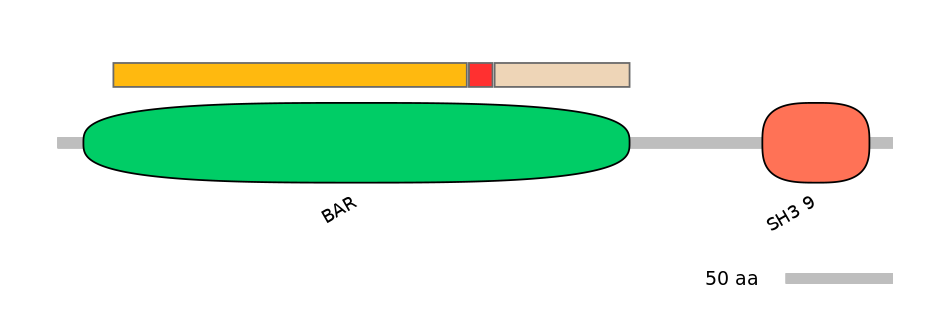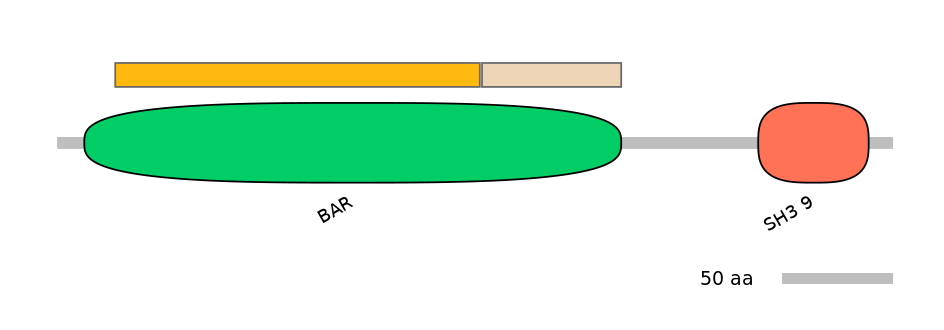DmeEX0004286 @ dm6
Exon Skipping
Gene
FBgn0034433 | EndoB
Description
The gene Endophilin B is referred to in FlyBase by the symbol DmelEndoB (CG9834, FBgn0034433). It is a protein_coding_gene from Dmel. It has 5 annotated transcripts and 5 polypeptides (4 unique). Gene sequence location is 2R:19307447..19310665. Its molecular function is described by: lysophosphatidic acid acyltransferase activity; phospholipid binding. It is involved in the biological process described with: clathrin-dependent endocytosis involved in vitellogenesis; membrane organization; vitellogenesis; plasma membrane tubulation. 12 alleles are reported. The phenotypes of these alleles manifest in: yolk granule; eye; mesothoracic tergum; oocyte. The phenotypic classes of alleles include: decreased fecundity; partially lethal - majority die; visible; viable; lethal - all die during larval stage; lethal. Summary of modENCODE Temporal Expression Profile: Temporal profile ranges from a peak of moderately high expression to a trough of low expression. Peak expression observed within 00-06 hour embryonic stages.
Coordinates
chr2R:19309393-19310313:-
Coord C1 exon
chr2R:19309816-19310313
Coord A exon
chr2R:19309663-19309698
Coord C2 exon
chr2R:19309393-19309583
Length
36 bp
Sequences
Splice sites
3' ss Seq
CTGCTGCCCGGAATTTTTAGAAA
3' ss Score
5.7
5' ss Seq
CAGGTATCA
5' ss Score
7.33
Exon sequences
Seq C1 exon
CTCACGGAGGAGAAACTGGGCACCACGGAGCGCACCGAGTACGACTTGCACTTCCAGAATCTCGCCGAGCGGGCTGATGTGACCAAGACATGGACGGAGAAGATAGTGCGCGACACAGAGTCGGTGCTGATACCCAATCCTCAGAACCGGGTCGAAGACTTCATCTTCGAGAAGATTGAAAAGTCGAAGCCAAAAAGGTTGAGCAACCTAGAGCACCTGGCTCTGGACATGATCGAGGCTGGGGGCGATTTCGGGCAGGATTTACCCTATGGTCAGGCTCTGATCAAGGTCGGCCAAGCGGAACAGAAACTGGGCCAGTGCGAGCACGACTTTATAGCCACCTCGGGCATTTGCTTTACACAGCCGTTGCGCAAGTTCCTAGACGGCGAAATGAAGACAATTGGCAAGGAGCGAGGCATCCTGGAGACCAAGCGCCTGGATCTGGACGCCTGCAAGAACAGGGTGAAGAAAGCGCGCAGCATGCTGGGTCAGCAATCG
Seq A exon
AAAGATGGCATCTCGCCAGAGGCCGTCTTGGAACAG
Seq C2 exon
GCGGAACGGGACTTGCGGGTGGCTCAGGCCGAGTTCGACCGGCAGGCGGAGATTACCAAGCTGCTGCTGGACGGGATCAGCACATCGCAGGCATCTCATTTGCGCCACTTGCACGCCTTCATCCAGACGCAAGTGCGCTACTACAAGCAGTGCGGCGATGTCATGGAGCAGCTGCAGCGTGAACTGGCCAA
VastDB Features
Vast-tools module Information
Secondary ID
FBgn0034433_CASSETTE1
Average complexity
S
Mappability confidence:
100%=100=100%
Protein Impact
Alternative protein isoforms (Ref)
No structure available
Features
Disorder rate (Iupred):
C1=0.024 A=0.625 C2=0.078
Domain overlap (PFAM):
C1:
PF0311413=BAR=FE(67.6=100),PF086386=Med14=PU(13.0=8.4)
A:
PF0311413=BAR=FE(4.3=100),PF086386=Med14=PU(2.1=16.7)
C2:
PF0311413=BAR=FE(24.6=100),PF086386=Med14=FE(65.6=100)
Main Inclusion Isoform:
FBpp0085742

Main Skipping Isoform:
FBpp0085743

Other Inclusion Isoforms:
FBpp0112010
Other Skipping Isoforms:
FBpp0112011
Associated events
Conservation
Primers PCR
Suggestions for RT-PCR validation
F:
GATCTGGACGCCTGCAAGAAC
R:
CAGCTTGGTAATCTCCGCCTG
Band lengths:
123-159
Functional annotations
There are 2 annotated functions for this event
PMID: 24523556
HsaEX0058019 and HsaEX0058023 are often included together. This splice isoform is associated with increased neuronal viability and mitochondrial elongation. The mitochondrial effect is associated with mitochondrial maintenance and function. Loss of this isoform is suggested to render neurons more susceptible to apoptotic stress.
PMID: 29759485
Isoforms 1b + 1c (represented by joint inclusion of this event and HsaEX0058019), show an antiapoptotic effect in human androgen-sensitive prostate cancer cell lines, while isoform 1a (corresponding to skipping of both exons) shows a pro-apoptotic effect. Isoforms 1b and 1c are up-regulated in patient-derived samples of treatment-induced neuroendocrine prostate cancer, which is a very aggressive and metastatic form of prostate cancer characterised by increased expression of SRRM4 (ENSG00000139767), a known master regulator of microexon inclusion in neuronal-related cell types. In contrast, prostate adenocarcinoma samples predominantly express isoform 1a.
GENOMIC CONTEXT[edit]
INCLUSION PATTERN[edit]
SPECIAL DATASETS
- Neural diversity
- Neurogenesis
- Neuronal activity
- Splicing factor regulation (brain)
- Splicing factor regulation (SL2)